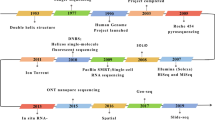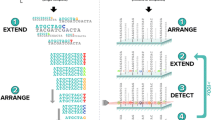Abstract
Objective
In this article, we provide a gestalt idea about NGS technologies and their applications in cancer research and molecular diagnosis.
Background
Next-generation sequencing (NGS) advancements like DNA sequencing and RNA sequencing allow uncovering of genomic, transcriptomic, and epigenomic scenes of individual malignant growths. An assortment of genomic abnormalities can be screened at the same time, for example common and uncommon variations, auxiliary variations like insertions and deletions, copy-number variation, and fusion transcripts.
Conclusion
NGS innovations together with bioinformatics investigation, which extend our insight, are progressively used to analyze multiple genes in a cost-effective way and have been applied in examining clinical cancer samples and offering NGS-based molecular diagnosis.
Application
NGS is progressively significant as a device for the diagnosis of cancers.
Similar content being viewed by others
Abbreviations
- NGS:
-
Next generation sequencing
- DNA:
-
Deoxy ribonucleic acid
- RNA:
-
Ribonucleic acid
- WES:
-
Whole exome sequencing
- WGS:
-
Whole genome sequencing
- NCDs:
-
Non-communicable diseases
- WHO:
-
World Health Organization
- HNCs:
-
Head and neck cancers
- SCC:
-
Squamous cell carcinoma
- GWAS:
-
Genome-wide association study
- SBS:
-
Sequencing by synthesis
- SMRT:
-
Single-molecule real-time
- CNV:
-
Copy number variations
- SNPs:
-
Single-nucleotide polymorphisms
- TCGA:
-
The cancer genome atlas
- WGBS:
-
Whole genome bisulphite sequencing
- RRBS:
-
Reduced representation bisulfite sequencing
- PC:
-
Prostrate cancer
- BC:
-
Breast cancer
- HNSCC:
-
Head and neck squamous cell carcinoma
References
Marziali A, Akeson M (2001) New DNA sequencing methods. Annu Rev Biomed Eng 3:195–223
World Health Organization (2018) Global Health Observatory. World Health Organization: Geneva. https://www.who.int/gho/database/en/. Accessed 21 June 21
Ferlay J, Soerjomataram I, Ervik M et al (2012) GLOBOCAN v1.0, cancer incidence and mortality worldwide. IARC Cancer Base No. 11. Lyon, International Agency for Research on Cancer, 2012. http://globocan.iarc.fr. Accessed 19 Oct 2015
van Oijen MG, Slootweg PJ (2000) Oral field cancerization: carcinogen-induced independent events or micrometastatic deposits? Cancer Epidemiol Biomark Prev 9:249–256
Byakodi R, Byakodi S, Hiremath S et al (2012) Oral cancer in India: an epidemiologic and clinical review. J Community Health 37:316–319
Furness S, Glenny AM, Worthington HV, Pavitt S, Oliver R, Clarkson JE et al (2010) Interventions for the treatment of oral cavity and oropharyngeal cancer: chemotherapy. Cochrane Database Syst Rev 9:CD006386
Gersten O, Wilmoth JR (2002) The cancer transition in Japan since 1951. Demogr Res 7:271–306
Bray F (2014) Transitions in human development and the global cancer burden. In: Stewart BW, Wild CP (eds) World cancer report 2014. IARC Press, Lyon, pp 42–55
Maule M, Merletti F (2012) Cancer transition and priorities for cancer control. Lancet Oncol 13:745–746
Gomy I, Diz Mdel P (2016) Hereditary cancer risk assessment: insights and perspectives for the next-generation sequencing era. Genet Mol Biol 39:184–188
Wang Q, Lu Q, Zhao H (2015) A review of study designs and statistical methods for genomic epidemiology studies using next generation sequencing. Front Genet 6:149
Wang KS, Zuo L, Luo X (2014) Genetic factors for alcohol dependence and schizophrenia: common and rare variants. Austin J Drug Abuse Addict 1:id1001
Li W, Zhao K, Kirberger M, Liao W, Yan Y (2015) Next generation sequencing technologies in cancer diagnostics and therapeutics: a mini review. Cell Mol Biol 61:91–102
Luthra R, Chen H, Roy-Chowdhuri S, Singh RR (2015) Next-generation sequencing in clinical molecular diagnostics of cancer: advantages and challenges. Cancers 7:2023–2036
Corless CL (2016) Next-generation sequencing in cancer diagnostics. J Mol Diagn 18:813–816
Serratì S, De Summa S, Pilato B, Petriella D, Lacalamita R et al (2016) Next-generation sequencing: advances and applications in cancer diagnosis. Onco Targets Ther 9:7355–7365
Kamps R, Brandão RD, Bosch BJ, Paulussen AD, Xanthoulea S et al (2017) Next-generation sequencing in oncology: genetic diagnosis, risk prediction and cancer classification. Int J Mol Sci 18:308
Illumina®. http://www.illumina.com. Accessed 10 Jan 2017
Ion-Torrent®. http://www.thermofisher.com. Accessed 7 Nov 2016
PacBio®. http://www.pacb.com/. Accessed 11 Nov 2016
Roche®. http://www.roche.com/. Accessed 11 Nov 2016
Nanopore®. https://www.nanoporetech.com/. Accessed 11 Nov 2016
LeBlanc VG, Marra MA (2015) Next-generation sequencing approaches in cancer: Where have they brought us and where will they take us? Cancers 7:1925–1958
Yadav SS, Li J, Lavery HJ, Yadav KK, Tewari AK (2015) Next-generation sequencing technology in prostate cancer diagnosis, prognosis, and personalized treatment. Urol Oncol 33:267
Suhaimi SS, Ab Mutalib NS, Jamal R (2016) Understanding molecular landscape of endometrial cancer through next generation sequencing: What we have learned so far? Front Pharmacol 7:409
Singleton AB (2011) Exome sequencing: a transformative technology. Lancet Neurol 10:942–946
The cancer genome atlas (2017)
International cancer genome consortium (2017)
Esteller M (2011) Non-coding RNAs in human disease. Nat Rev Genet 12:861–874
Farazi TA, Hoell JI, Morozov P, Tuschl T (2013) MicroRNAs in human cancer. Adv Exp Med Biol 774:1–20
Gagan J, Van Allen EM (2015) Next-generation sequencing to guide cancer therapy. Genome Med 7:80
Lin PH, Kuo WH, Huang AC, Lu YS, Lin CH et al (2016) Multiple gene sequencing for risk assessment in patients with early-onset or familial breast cancer. Oncotarget 7:8310–8320
Johansen Taber KA, Dickinson BD, Wilson M (2014) The promise and challenges of next-generation genome sequencing for clinical care. JAMA Intern Med 174:275–280
Manolio TA, Chisholm RL, Ozenberger B, Roden DM, Williams MS et al (2013) Implementing genomic medicine in the clinic: the future is here. Genet Med 15:258–267
Rabbani B, Tekin M, Mahdieh N (2014) The promise of whole-exome sequencing in medical genetics. J Hum Genet 59:5–15
Leyten GH, Hessels D, Smit F, Jannink S, de Jong H et al (2015) Identification of a candidate gene panel for the early diagnosis of prostate cancer. Clin Cancer Res 21:3061–3070
Chen J, Zhang D, Yan W, Yang D, Shen B (2013) Translational bioinformatics for diagnostic and prognostic prediction of prostate cancer in the next-generation sequencing era. Biomed Res Int 2013:901578
Pronina IV, Loginov VI, Burdennyy AM, Fridman MV, Senchenko VN et al (2017) DNA methylation contributes to deregulation of 12 cancer-associated microRNAs and breast cancer progression. Gene 604:1–8
Millis SZ, Ikeda S, Reddy S, Gatalica Z, Kurzrock R (2016) Landscape of phosphatidylinositol-3-kinase pathway alterations across 19?784 diverse solid tumors. JAMA Oncol 2:1565–1573
Agrawal N, Frederick MJ, Pickering CR, Bettegowda C, Chang K, Li RJ et al (2011) Exome sequencing of head and neck squamous cell carcinoma reveals inactivating mutations in NOTCH1. Science 333(6046):1154–1157
Stransky N, Egloff AM, Tward AD, Kostic AD, Cibulskis K, Sivachenko A et al (2011) The mutational landscape of head and neck squamous cell carcinoma. Science 333(6046):1157–1160
The Cancer Genome Atlas N (2015) Comprehensive genomic characterization of head and neck squamous cell carcinomas. Nature 517(7536):576–582
Author information
Authors and Affiliations
Corresponding author
Additional information
Publisher's Note
Springer Nature remains neutral with regard to jurisdictional claims in published maps and institutional affiliations.
Rights and permissions
About this article
Cite this article
Nair, S.V., Madhulaxmi, Thomas, G. et al. Next-Generation Sequencing in Cancer. J. Maxillofac. Oral Surg. 20, 340–344 (2021). https://doi.org/10.1007/s12663-020-01462-4
Received:
Accepted:
Published:
Issue Date:
DOI: https://doi.org/10.1007/s12663-020-01462-4




